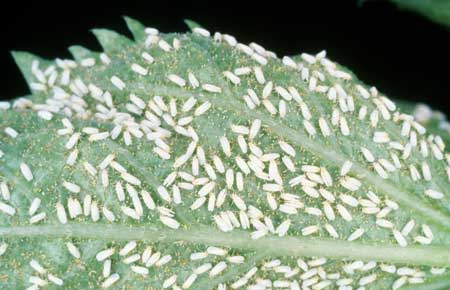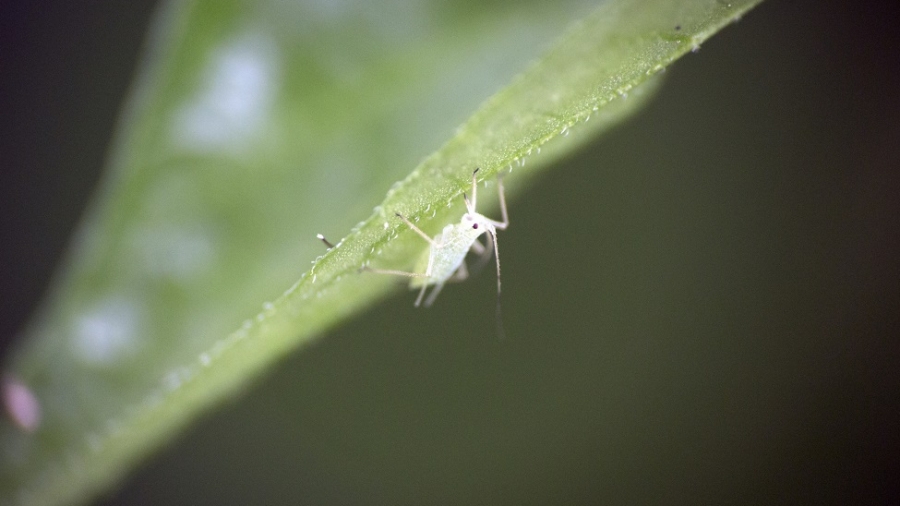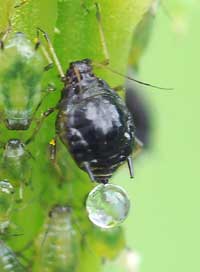Many common bugs are often very small and sometimes tough to identify. These bugs, if left unchecked can diminish your grow substantially. If at any point during your grow, you encounter an infestation, you most likely need to take action immediately. One thing I have learned about bugs is that they multiply rapidly. This gives you little time to take appropriate action. Therefore, I created this short blog to 1. help you identify your pest and 2. how to treat problem. So here is a quick summary of small white bugs on cannabis plants.
White Flies on Cannabis

Whether you grow in a greenhouse, indoors or outdoors you gotta watch out for white flies. White flies are easy to identify. These small, moth like white flies are usually found on your leaf undersides. When disturbed, these flies will fly off your plant. White flies are sap suckers. They suck the nutrients right from your plant. This can stunt growth and cause your foliage to yellow in color.
Treating white flies is medium/hard in my opinion. Since they have wings, and because they can fly, they are not always the easiest to treat. One way to alleviate white flies, is to place yellow sticky traps to catch them. This honestly requires zero skill on your part. The yellow sticky traps are affordable and work great. They won’t catch 100% though. Another way to control white flies is to use a insecticidal soap. You can purchase a organic one or make your own. Make sure not to disturb your plant before spraying because they will fly alway before your spray gets there.
Mealybugs on Cannabis
Mealybugs are my worst nightmare. They are not very pleasant to look at. If left unchecked, Mealybugs can explode onto the scene. These small little white bugs (1/20″ – 1/5″ inch) are sometimes tough to identify. They are often mistaken as a mildew or fungus because they produce cotton like growth. This scale insect is also a sap sucker. They feed themselves by sucking the nutrients out of your plant. These bugs can be found anywhere, but are most often found along joints and the veins of your leaves.
Hopefully your plants are still in VEG. Mealybugs during flower seems catastrophic. Nonetheless, there are several ways to treat Mealybugs. One way to treat Mealybugs is spray neem oil on them. Neem oil works good against Mealybugs, but you often have to use more than once to get them all. Other methods of treatment include insecticidal soaps and horticultural oils.
Spider Mites on Cannabis
Spider mites are another group of bugs that travel in mass colonies. They look to set up and take over entire grows. Spider mites are also tough to control and eradicate. Spider mites are very small and can barely be seen. They spin a fine, silky web that can cover your entire plant. If left unchecked, they can cover an entire grow room.
Before I start discussing ways to treat spider mites, I want to make one thing clear. Spider mites are almost impossible to get rid of 100%. The best course of treatment is discovering them early before their population gets outta control. They are tough little bugs! I usually encounter spider mite infestations indoors, but are sometimes found outdoors or in greenhouses as well. Spider mites are easier to treat during VEG. For this, my favorite course of treatment is to spray them down with water. Sometimes though, I understand that this might not be possible. Maybe because your plant is too big or because taking them outside is simply not an option. But if your plants are small enough to move outside and in VEG, let them have it with your hose. It works good. FYI, spraying water can damage and stress out your plant so be careful. Your next course of treatment depends on your situation. Neem oil, insecticidal soaps and organic miticides also work good.
Aphids on Cannabis
At least for me, aphids are the most common bug I encounter in my garden. These small, teardrop shaped bugs are usually found grouped together on the new foliage or the undersides of your leaves. They cause deformed leaves and stunt plant growth. Aphids come in a bunch of different colors but are easy to spot.
Aphids are easy to keep at bay, but hard to eradicate completely. My favorite method is spraying water to knock them off. As you noticed, spraying water is kinda a go to for me. I like the water treatment because doesn’t require any spraying. In my opinion, it is a good first course of treatment. Of course you should only spray your plant(s) with water if they are in VEG. Do not hose them down with water if your plants are full bloom unless its a last resort. Neem oil, insecticidal soaps and bio organic miticides also work good.
Small White Bugs on Cannabis Plants Conclusion
I hope this quick summary of small white bugs on cannabis plants helped a little. Remember to just do your best and learn from your mistakes. Bugs are part of the game. They are literally everywhere! Always try and avoid spraying when possible, even if it is an organic spray. Definitely avoid spraying during flower. When possible, try and remove by hand. Good luck!!
How to Identify Aphids on Cannabis Plants (also called greenflies and blackflies)
Aphids are soft-bodied insects which can appear white, green, yellow, black, brown and red, depending on their stage of life and where you live. Because they’re so widespread they can be a cannabis pest almost anywhere in the world!
Aphids look very different depending on their stage of life. In this picture, the bigger, rounder bugs are adult aphids, while the white, smaller, thinner bugs are young aphids (nymphs). Note: If you’re seeing white bugs that look like tiny fat worms, you may actually have thrips.
Aphids are a common cannabis pest. Adults are usually small and oval-shaped and may have visible wings or antennae. Nymph aphids are thin/long and usually white or pale. Because nymphs are so small, they may look like little white specks or eggs.
Aphids pierce cannabis leaves with their sucking mouth-parts and feed on the juices inside. They usually occur in colonies located mainly on the undersides of stems and leaves. If a cannabis plant becomes heavily-infested, its leaves can turn yellow and/or wilt due to the excessive stress and leaf damage.
“Honeydew” and Black Sooty Mold
Another problem with aphids is they produce large amounts of a sweet substance known as “honeydew,” which is a sugary liquid waste. Honeydew drops from these insects attract a type of fungus called sooty mold. Sooty mold can grow on honeydew deposits, accumulating on the leaves and branches of your plant and turning them black. Not only does this mold discolor the plants and somewhat hinder normal plant processes, sooty mold on buds can make them unsafe to smoke. And just to be an extra pain in the butt, the drops of sweet honeydew can also attract other insects such as ants.
What Causes an Aphid Infestation?
Your plant can become infested when winged “colonizer” aphids land on the plant and lay eggs. Although you may not see the winged version of an aphid actually eating your plant, they are still dangerous because they can lay eggs and start a new aphid colony! Winged aphids are sometimes called “blackfly” or “greenfly” bugs depending on the color (because they are often black or green/yellow, and they look like tiny flies).
Aphids are sometimes called “Green Flies” or “Black Flies” when they have wings, but the general body shape is the same. The winged versions appear when the aphid colony gets too numerous and these bugs use their wings to fly away and lay eggs on other plants. This “black fly” is actually a winged aphid.
It’s difficult to prevent aphids from getting to your cannabis plants outdoors as just a handful of winged aphids is all it takes to start an infestation. The eggs soon hatch into a juvenile form of aphids called “nymphs,” which happily start munching on your plant.
This grower started seeing white specks on their buds and thought it might be mold or bud rot. The specks were actually white aphid nymphs. Click the picture for a closeup!


I hate those things. They and I are having a daily fight. I can’t believe how much juice they can suck from my plants!